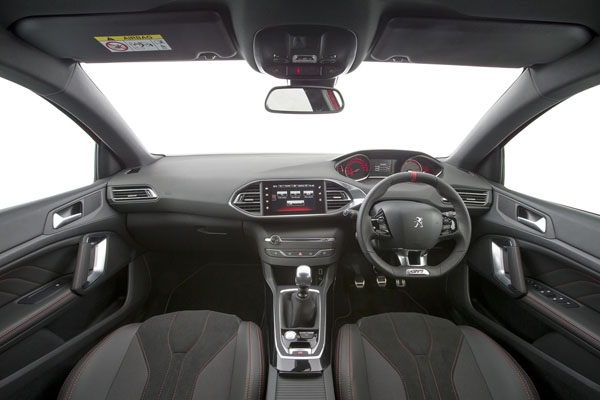
Peugeot 308 GTi isn’t just a dress up kit added on the assembly line, its engineering was carried done by Peugeot Sport. That’s the division which builds Peugeots for ultra-tough competitions in events like the Dakar rally and the Pike’s Peak hillclimb.
This hot French GTi is offered in two specifications: the Peugeot 308 GTi 250 has a recommended retail price of $44,990, the 308 GTi 270 is sold at $49,990. On-road costs have to be added. The 250 and 270 refer to the output of the engines in horsepower. For details an Australian terms see the Engine section of the review.
Our test car was the GTi 250 and came without the added-cost extras that crop up in a lot of our test vehicles.
The Peugeot is powered by a responsive turbo-petrol engine that drives through well-controlled front wheels, and chassis dynamics that sit with the best of them.
STYLING
The French designers have given the 308 GTi a shape that’s stylish, but certainly not overdone. We used the term ‘understated aggression’ when we first sampled it during the media launch in Tasmania a couple of months back. After a week’s test in real world conditions our home territory in the Gold Coast and Brisbane regions it makes even more sense. Other drivers don’t perceive it as a hot hatch so there are no challenges off the lights…
The sports grille and revised side skirts look good. The rear features a gloss-black section incorporating twin exhaust pipes that are finished in chrome. There are ‘GTi’ badges on the front guards, rear hatch, door sills and steering wheel.
These Peugeot GTi models are lower by 11 mm than the standard 308 and have wider tracks – 1570 mm at the front and 1554 mm at the rear. The 250 has 225/40 R18 Michelin Pilot Sport 3 tyres on Diamant alloy wheels. The GTi 270 sits on 19-inch Carbone light-weight alloy wheels with wider, lower-profile Michelin Super Sport 235/35 R19 tyres.
Interior trim is in a combination of mock leather, and alcantara in dark grey with red stitching on the seats and door trim. The gear knob and steering wheel also get stitching highlights.
ENGINES / TRANSMISSIONS
Both models use the same 1.6-litre four-cylinder turbo-petrol engine, but in two different states of tune. The numbers 250 and 270 in the GTi’s title refer to the output of the engines in horsepower. Metric power is rated at 184 and 200 kW.
Torque is more important than power in real life driving and is a strong feature of this powerplant; both versions of the engine develop peak torque of 330 Nm from just 1900 rpm. In other words top torque is on hand virtually all the time.
The 250 engine has a zero to 100 km/h acceleration time of 6.2 seconds, the 270 stops the timer at 6.0.
Peugeot GTi only comes with a six-speed manual gearbox. The company refuses to either confirm or deny its engineers are working on an automatic transmission. We would like to speculate that a sports-tuned dual-clutch auto is on the way. Given the faster shifts offered by a dual-clutch it’s likely the 270 would easily drop into the five-second bracket.
Then again, the skill required to change gears for yourself is something we really do enjoy. Long live manual cars!
The GTi 270 uses of a Torsen limited-slip differential and its Electronic Stability Program puts more emphasis on driver skill by cutting in later. The ESP system can be fully disconnected, though this is only recommended for track days.
INFOTAINMENT
Peugeot’s 9.7-inch touchscreen gets a “Redline” finish in a red and black theme. Satellite navigation is standard, there’s 6.9Gb Jukebox for music storage, AM/FM radio and a CD player. Two USB ports and Bluetooth connectivity complete the package.
Sound quality is good and we found the radio picking up signals at greater distances than we often experience in other cars. However the latter isn’t exactly a scientific back-to-back test and audio input is obviously influenced by atmospheric conditions.
DRIVING
The front seats are a Peugeot Sport design and support nicely, though not to the extent of making ingress and egress a chore. They appear to be slightly bulkier in their backrest design and therefore reduce rear-seat kneeroom. I’m a six-footer and anyone of the same height would find barely enough kneeroom behind me unless I was willing to give up a notch or three on my seat.
All seat adjustments are manual, something I’m happy with in a sports model as cutting a few kilos by leaving out electric motors is always nice.
I enjoy the tiny low-set steering wheel that you look over the top of, but find Peugeot’s description of this as being a ‘head-up display’ a bit imaginative.
A feature I love is that the speedo and tacho needles rotate in opposite directions. Some people find this irritating – but they fail to see the challenge is to get the tips of the two needles as close to on another as possible. Having said that, we never did achieve the ultimate needle position of 250 km/h at 6500 rpm!
Engine response is very good for a high-performance turbo engine, the small capacity probably helps here. The ability to get out and around slower cars quickly and safely is always welcome.
Pressing the Sport button on the centre console switches the instrument display from white to an angry red, it shows additional information on the central read-out (power, torque, boost, lateral and longitudinal acceleration).
Even better, using Sport mode enhances the engine’s throaty growl. A little more volume would be appreciated, though.
Steering is fast, intuitive and predictable and the ability of this hot French machine to cling on in bends and change direction quickly when asked to do really pleases those who enjoy driving.
On smooth roads the Peugeot can carry you long distances with ease thanks to the well known ability of the French suspension folks to combine handling and comfort.
But road roar on coarse-chip surfaces is probably too high if you just want a sporty looking cruiser. We’re sure keen drivers will put up with the noise for the added grip.
SUMMING UP
Serious drivers should try the Peugeot GTi 270 if they are considering track days. Those simply looking for an excellent on-road performer will probably be satisfied with the 250 and save $5000 – why not test drive both, before making you your mind though?
AT A GLANCE
MODEL RANGE
308 GTi 250 1.6-litre turbo-petrol five-door hatch: $44,990 (manual)
308 GTi 270 1.6-litre turbo-petrol five-door hatch: $49,990 (manual)
Note: These prices do not include government or dealer delivery charges. Contact your local Peugeot dealer for drive-away prices.
SPECIFICATIONS (Peugeot 308 GTi 250 1.6-litre turbo-petrol five-door hatch)
ENGINE:
Capacity: 1.598 litres
Configuration: Four cylinders in line
Maximum Power: 184 kW @ 6000 rpm
Maximum Torque: 330 Nm @ 1900 rpm
Fuel Type: Petrol 98ROM
Combined Fuel Cycle (ADR 81/02): 6.0 L/100km
CO2 Emissions: 139 g/km
DRIVELINE:
Six-speed manual
DIMENSIONS, WEIGHT AND CAPACITIES:
Length: 4253 mm
Wheelbase: 2620 mm
Width: 1804 mm
Height: 1446 mm
Turning Circle: Not supplied
Kerb Mass: 1205 kg
Fuel Tank Capacity: 53 litres
BRAKES:
Front: Ventilated disc
Rear: Solid disc
STANDARD WARRANTY:
Three years / 100,000 kilometres













